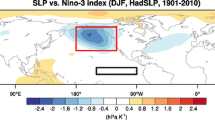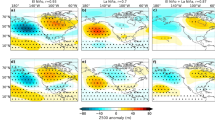Abstract
The relationship between the El Niño Southern Oscillation (ENSO) and the Southern Hemisphere Annular Mode (SAM) is examined, with the goal of understanding how various strong SAM events modulate the ENSO teleconnection to the South Pacific (45°–70°S, 150°–70°W). The focus is on multi-month, multi-event variations during the last 50 years. A significant (p < 0.10) relationship is observed, most marked during the austral summer and in the 1970s and 1990s. In most cases, the significant relationship is brought about by La Niña (El Niño) events occurring with positive (negative) phases of the SAM more often than expected by chance. The South Pacific teleconnection magnitude is found to be strongly dependent on the SAM phase. Only when ENSO events occur with a weak SAM or when a La Niña (El Niño) occurs with a positive (negative) SAM phase are significant South Pacific teleconnections found. This modulation in the South Pacific ENSO teleconnection is directly tied to the interaction of the anomalous ENSO and SAM transient eddy momentum fluxes. During La Niña/SAM+ and El Niño/SAM− combinations, the anomalous transient momentum fluxes in the Pacific act to reinforce the circulation anomalies in the midlatitudes, altering the circulation in such a way to maintain the ENSO teleconnections. In La Niña/SAM− and El Niño/SAM+ cases, the anomalous transient eddies oppose each other in the midlatitudes, overall acting to reduce the magnitude of the high latitude ENSO teleconnection.














Similar content being viewed by others
References
Allan R, Ansell T (2006) A new globally complete monthly historical gridded mean sea level pressure dataset (HadSLP2): 1850–2004. J Clim 19:5816–5842
Bromwich DH, Fogt RL (2004) Strong trends in the skill of the ERA-40 and NCEP-NCAR reanalyses in the high and middle latitudes of the Southern Hemisphere, 1958–2001. J Clim 17:4603–4619
Bromwich DH, Monaghan AJ, Guo Z (2004) Modeling the ENSO modulation of Antarctic climate in the late 1990s with Polar MM5. J Clim 17:109–132
Bromwich DH, Fogt RL, Hodges KI, Walsh JE (2007) A tropospheric assessment of the ERA-40, NCEP, and JRA-25 global reanalyses in the polar regions. J Geophys Res 112. doi:10.1029/2006JD007859
Carvalho LMV, Jones C, Ambrizzi T (2005) Opposite phases of the Antarctic Oscillation and relationships with intraseasonal to interannual activity in the Tropics during the austral summer. J Clim 18:702–718
Chen B, Smith SR, Bromwich DH (1996) Evolution of the tropospheric split jet over the South Pacific Ocean during the 1986–89 ENSO cycle. Mon Wea Rev 124:1711–1731
Comiso JC, Nishio F (2008) Trends in the sea ice cover using enhanced and compatible AMSR-E, SSM/I, and SMMR data. J Geophys Res 113. doi:10.1029/2007JC004257
Fogt RL, Bromwich DH (2006) Decadal variability of the ENSO teleconnection to the high latitude South Pacific governed by coupling with the Southern Annular Mode. J Clim 19:979–997
Gong T, Feldstein SB, Luo D (2010) The impact of ENSO on wave breaking and Southern Annular Mode events. J Atmos Sci (in press)
Gregory S, Noone D (2008) Variability in the teleconnection between the El Niño- Southern Oscillation and West Antarctic climate deduced from West Antarctic ice core isotope records. J Geophys Res 113. doi:10.1029/2007JD009107
Hines KM, Bromwich DH, Marshall GJ (2000) Artificial surface pressure trends in the NCEP-NCAR reanalysis over the Southern Ocean and Antarctica. J Clim 13:3940–3952
Hoskins BJ, James IN, White GH (1983) The shape, propagation, and mean-flow interaction of large-scale weather systems. J Atmos Sci 40:1595–1612
Jones PD, Lister DH (2007) Intercomparison of four different Southern Hemisphere sea level pressure datasets. Geophys Res Lett 34. doi:10.1029/2007GL029251
Kalnay R et al (1996) The NCEP-NCAR 40-year reanalysis project. Bull Am Meteorol Soc 77:437–471
Karoly DJ (1989) Southern Hemisphere circulation features associated with El Niño–Southern Oscillation events. J Clim 2:1239–1252
Kwok R, Comiso J (2002) Spatial patterns of variability in Antarctic surface temperature: Connections to the Southern Hemisphere Annular Mode and the Southern Oscillation. Geophys Res Lett 29. doi:10.1029/20002GL015415
L’Heureux ML, Thompson DWJ (2006) Observed relationships between the El-Niño/Southern Oscillation and the extratropical zonal-mean circulation. J Clim 19:276–287
Lachlan-Cope T, Connolley W (2006) Teleconnections between the tropical Pacific and the Amundsen-Bellingshausen Seas: role of the El Niño–Southern Oscillation. J Geophys Res 111. doi:10.1029/2005JD006386
Lefebvre W, Goose H, Timmermann R, Fichefet T (2004) Influence of the Southern Annular Mode on the sea ice-ocean system. J Geophys Res 109, C09005. doi:10.1029/2004JC002403
Limpasuvan V, Hartmann DL (1999) Eddies and the annular modes of climate variability. Geophys Res Lett 26:3133–3136
Marshall GJ (2003) Trends in the Southern Annular Mode from observations and reanalyses. J Clim 16:4134–4143
Mo KC, Ghil M (1987) Statistics and dynamics of persistent anomalies. J Atmos Sci 44:877–901
Mo KC, Paegle JN (2001) The Pacific-South American modes and their downstream effects. Int J Climatol 21:1211–1229
Oort AH, Peixoto JP (1983) Global angular momentum and energy balance requirements from observations. Adv Geophys 25:355–490
Renwick JA, Revell MJ (1999) Blocking over the South Pacific and Rossby wave propagation. Mon Wea Rev 127:2233–2247
Schneider DP, Steig EJ (2008) Ice cores record significant 1940s Antarctic warmth related to tropical climate variability. Proc Natl Acad Sci 105:12154–12158
Seager R, Harnik N, Kushnir Y, Robinson W, Miller J (2003) Mechanisms of hemispherically symmetric variability. J Clim 16:2960–2978
Silvestri GE, Vera CS (2003) Antarctic Oscillation signal on precipitation anomalies over southeastern South America. Geophys Res Lett 30. doi:10.1029/2003GL018277
Smith TM, Reynolds RW, Peterson TC, Lawrimore J (2008) Improvements to NOAA’s historical merged land-ocean surface temperature analysis (1880–2006). J Clim 21:2283–2296
Stammerjohn SE, Martinson DG, Smith RC, Yuan X, Rind D (2008) Trends in Antarctic annual sea ice retreat and advance and their relation to El Niño-Southern Oscillation and Southern Annular Mode variability. J Geophys Res 113. doi:10.1029/2007JC004269
Steig E, Schneider DP, Rutherford SD, Mann ME, Comiso JC, Shindell DT (2009) Warming of the Antarctic ice-sheet surface since the 1957 International Geophysical Year. Nature 457. doi:10.1038/nature07669
Sterl A, van Oldenborgh GJ, Hazeleger W, Burgers G (2007) On the robustness of ENSO teleconnections. Clim Dyn 29:469–485
Thompson DWJ, Wallace JM (2000) Annular modes in the extratropical circulation. Part I: month-to-month variability. J Clim 13:1000–1016
Trenberth KE (1986) An assessment of the impact of transient eddies on the zonal mean flow during a blocking episode using localized Eliassen-Palm flux diagnostics. J Atmos Sci 43:2070–2087
Trenberth KE (1991) Storm tracks in the Southern Hemisphere. J Atmos Sci 48:2159–2178
Trenberth KE, Caron JM (2000) The Southern Oscillation revisited: sea level pressures, surface temperatures, and precipitation. J Clim 13:4358–4365
Turner J (2004) Review: The El Niño-Southern Oscillation and Antarctica. Int J Climatol 24:1–31
Ventura V, Paciorek CJ, Risbey JS (2004) Controlling the proportion of falsely rejected hypotheses when conducting multiple tests with climatological data. J Clim 17:4343–4356
Yuan X (2004) ENSO-related impacts on Antarctic sea ice: a synthesis of phenomenon and mechanisms. Antarct Sci 16:415–425
Yuan X, Martinson DG (2000) Antarctic sea ice extent variability and its global connectivity. J Clim 13:1697–1717
Zwally HJ, Comiso JC, Parkinson CL, Cavalieri DJ, Gloersen P (2002) Variability of Antarctic sea ice 1979–1998. J Geophys Res 107. doi:10.1029/2000JC000733
Acknowledgments
A portion of this work was conducted while RLF held a National Research Council Research Associateship Award at NOAA. All authors acknowledge support from NSF ATM grant #0751291. RLF also acknowledges support from NSF OPP grant #ANT-0944168. Two anonymous reviewers are thanked for their comments which helped to improve the manuscript and clarify our main points.
Author information
Authors and Affiliations
Corresponding author
Additional information
Contribution 1400 of the Byrd Polar Research Center.
Rights and permissions
About this article
Cite this article
Fogt, R.L., Bromwich, D.H. & Hines, K.M. Understanding the SAM influence on the South Pacific ENSO teleconnection. Clim Dyn 36, 1555–1576 (2011). https://doi.org/10.1007/s00382-010-0905-0
Received:
Accepted:
Published:
Issue Date:
DOI: https://doi.org/10.1007/s00382-010-0905-0




